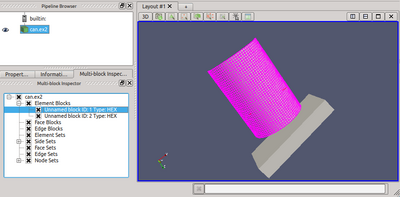ParaView/Users Guide/Multi-Block Inspector: Difference between revisions
From KitwarePublic
< ParaView
Jump to navigationJump to search
No edit summary |
No edit summary |
||
| Line 8: | Line 8: | ||
The visibility of individual blocks can be changed by toggling the check box next to their name. By default, blocks will inherit the visibility status of their parent block. Thus, changing the visibility of a non-leaf block will also change the visibility of each child block. | The visibility of individual blocks can be changed by toggling the check box next to their name. By default, blocks will inherit the visibility status of their parent block. Thus, changing the visibility of a non-leaf block will also change the visibility of each child block. | ||
== Selection Linking == | |||
Selections made in the render-view will be linked with the items in the multi-block inspector and visa versa. Using block selection (Ctrl-B) and clicking on a block will result in that block being highlighted in the tree view. | |||
[[Image:MultiBlockInspectorSelection.png|thumb|center|400px|'''Block Selection Linking''']] | |||
Revision as of 19:13, 14 March 2013
Introduction
The Multi-Block Inspector panel allows users to change the rendering and display properties for individual blocks within a multi-block data set.
Block Visibility
The visibility of individual blocks can be changed by toggling the check box next to their name. By default, blocks will inherit the visibility status of their parent block. Thus, changing the visibility of a non-leaf block will also change the visibility of each child block.
Selection Linking
Selections made in the render-view will be linked with the items in the multi-block inspector and visa versa. Using block selection (Ctrl-B) and clicking on a block will result in that block being highlighted in the tree view.
